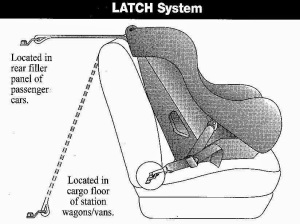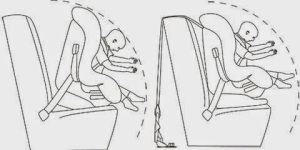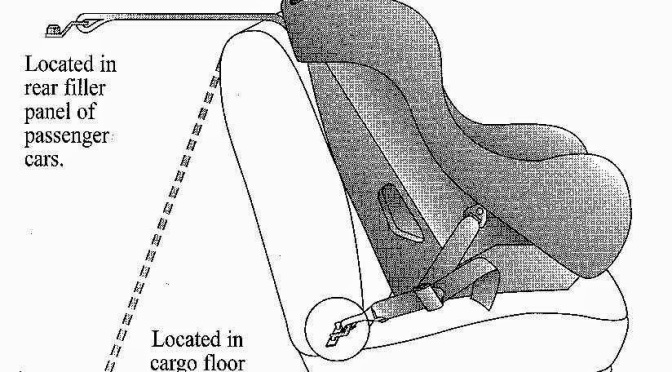If there’s one thing certain about car seat safety (besides the benefits of extended rear-facing), it’s that the whole affair can be incredibly confusing! LATCH or seat belts? What is LATCH? Why rear-face past 1? Which seat position is the safest? Why do they expire? It goes on and on. However, what I’d like to do today is talk about tethers and why using them when forward-facing car seats is a very good idea.
First of all, fewer than 30% of forward-facing children in the US are tethered, when 100% should be. Of those 28% of tethered children, only 59% are even tethered correctly! The specific percentages have increased and decreased a bit, but they’re basically the same, much as how roughly 33% of collision deaths have been due to alcohol for the last several decades. Ridiculous. However, on the bright side, if 30% of parents are using tethers, that simply means that we need to spread the word to the other 70%, right? Let’s do it!
 What are tethers?
What are tethers?
Tethers, which are also known as top tethers or straps, are essentially seat belts that attach to the top rear portion of convertible or combination seats. In the United States, they are almost always attached to forward-facing seats. They are sometimes attached to rear-facing seats, but I’ll discuss that later. The point is that tethers are designed to attach to car seats and to tether anchors, or secure points on the vehicle, to keep the top of the car seat from moving in a collision.
 Why use them when forward-facing car seats?
Why use them when forward-facing car seats?
Using them reduces head excursion by, on average, 7 inches. What’s head excursion, and why is that a big deal? Head excursion is just a fancy term for the movement of an individual’s (in this case, a child’s) head forward in a collision. And yes, 7 inches (or 6-8 inches, on average), is a big deal when it comes to car seats! Seven inches can mean the difference between a collision where a child can simply be unbuckled and walk out of a seat uninjured and a collision where the same child suffers serious or even fatal injuries from hitting a part of the vehicle during the collision, such as the side pillars, windows, or of course, the seat in front of the child. And yes, that can happen even while a child is completely and securely restrained if a tether isn’t being used.
According to Federal standards, it’s okay for a child’s head to move forward by up to 32″ if s/he sits in a seat without a tether. On the other hand, if a tether is connected, only 28″ of head excursion are allowed. Both are large amounts, but it can be the difference between a child’s head smashing into the back of a front seat and…not. At the speeds of a crash, that contact (or lack thereof) can easily mark the difference between death and life. And the scary thing is that in most vehicles, there is far less than 32″ of space between the back of the back seat and the back of the front seat. Take a yardstick out to your car sometime and measure that distance. If you’ve got a small car (e.g., a Civic or Corolla), it gets worse. If you’ve got a minicar (e.g., a Fiesta, Fit, or Yaris), it gets gruesome. This, by the way, is another reason to rear-face; the back of your child’s car seat is what will hit the front seat, if it hits at all, rather than the front of your child’s head.
Is it hard to use a tether?
Absolutely not. You simply attach it to your car seat, attach it to your vehicle’s anchor point, and that’s it. For something that can make such a difference, it really doesn’t take much effort. Choose the tether anchor right behind the seat in which you’ve installed your forward-facing car seat. For example, if you’ve got a seat in the right passenger seat, you’ll need to use the right passenger tether anchor; you can’t use tethers meant for different seats. It’s okay for tethers to be 20 degrees off-center relative to the seat, but this is simply to give vehicle manufacturers room for tether anchor setups.
If you aren’t sure where the anchor points are on your vehicle, consult your manual or take your vehicle to a CPST who will be happy to show you. If you can’t find your vehicle’s manual, all you need to do is Google it (e.g., “2001 Honda Accord owner’s manual” if you have a 2001 Honda Accord), and you’ll find it online. Sometimes you’ll see a PDF freely available, and other times you’ll need to enter your VIN number at the manufacturer’s website. Either way, you’ll be able to find it. If you have trouble finding yours, shoot me an email and I’ll find it for you and send it to you for free. It’s that important.
How often should a tether be used?
Use a tether every single time you have a harnessed, forward-facing child. Although you’re not required to do so by law in the US (you are in Canada), it’s part of basic forward-facing car safety, just like making sure you harness your child and that his or her shoulders are below the harness straps. You should use the tether whether you’ve got the seat installed via lower LATCH connectors or via the seat belt, which I prefer. Keep in mind that certain car seats require tether use. For example, under specific circumstances, Clek requires the tether to be used while forward-facing.
When boostering, tethering isn’t required, but it can be used as a safety feature for additional passengers, as the tether keeps an empty seat from turning into a deadly projectile during a collision. However, best practice indicates that a booster seat should always be buckled in via a seat belt, whether a child is inside it or not.
I look forward to the day when the US rate of tether use approaches 100%. Remember to use a tether whenever you have a forward-facing car seat, regardless of whether the seat is attached via lower LATCH anchors or via a seat belt. Keep in mind that you can have tether anchors installed for free or for low cost in most vehicles if they don’t already have tether anchors present.
Remember…take the time to choose the right car seat, and if it’s forward-facing, get it tethered!
—
If you find the information on car safety, recommended car seats, and car seat reviews on this car seat blog helpful, you can shop through this Amazon link for any purchases, car seat-related or not. Canadians can shop through this link for Canadian purchases.

